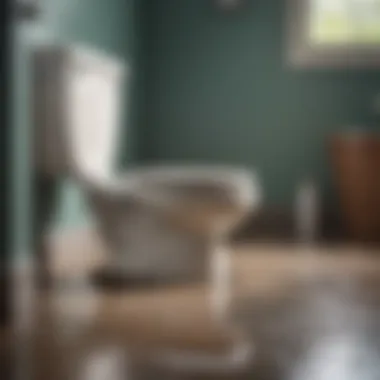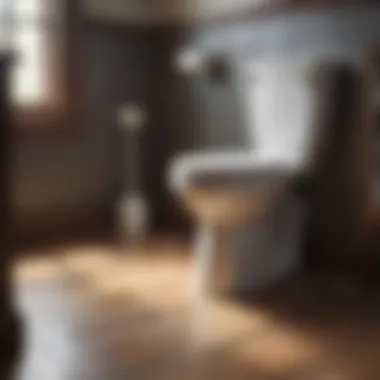Stopped Up Toilet Solutions: Effective Approaches


Intro
Toilets are a vital part of any home, regardless of whether you own or rent. We often take their function for granted, yet a stopped-up toilet can disrupt daily life. Understanding the common causes and solutions for this issue is crucial. This article aims to explore practical approaches that anyone can utilize, ensuring you remain equipped with the knowledge needed to tackle this problem head-on.
From immediate fixes that can help in a jam to proactive measures that prevent future clogs, we will cover a variety of strategies. This discussion will also address how the mechanics of plumbing work, and when it's necessary to call in a professional.
As we delve into this topic, we will prioritize actionable insights and easy-to-understand solutions to empower homeowners and renters alike. With the right tools and knowledge, managing toilet issues becomes a manageable task.
Understanding Stopped Up Toilets
Understanding the nature of stopped up toilets is essential for any homeowner or renter. Toilets are a critical aspect of domestic plumbing, and their operation greatly affects daily life. Learning about the common causes and signs of clogs provides the first line of defense against more severe plumbing issues. Recognizing potential problems early can save time, stress, and costly repairs.
Common Causes of Toilet Clogs
Excessive Toilet Paper Usage
Excessive use of toilet paper is a frequent contributor to clogging toilets. Many users do not realize that flushing large amounts of toilet paper can lead to blockages. The key characteristic of this issue is related to the paper's ability to absorb water and expand, creating a mass that may not displace smoothly within the pipes. While toilet paper is designed to break down, using too much at once can overwhelm the toilet's flushing mechanisms. Reducing the quantity of paper used per flush can be a simple but effective solution in preventing clogs.
Foreign Objects
Foreign objects are another common cause for toilet blockages. Items such as hygiene products, children's toys, or fabric can easily find their way into the toilet. The key characteristic of foreign objects is that they are not meant to be flushed, impacting the flow and functionality of the plumbing system. Notably, this issue underscores the necessity for proper disposal methods separate from toilet usage. Removing foreign objects promptly can prevent a worsening clog and associated plumbing problems.
Improper Disposal of Waste
Improper disposal of waste is a significant contributor to stopped toilets. Some individuals flush items that should not be disposed of this way, like wipes or other personal hygiene products. The key characteristic of this behavior lies in a lack of awareness or understanding of what the plumbing can reasonably handle. A clear communication regarding disposal best practices is beneficial in reducing the frequency of clogs caused by human error. Ultimately, educating users on proper waste disposal can significantly aid in preventing obstructions.
Hard Water Buildup
Hard water buildup is often overlooked as a contributing factor to clogged toilets. The minerals in hard water can accumulate over time, limiting the flow within toilet pipes. The key characteristic of hard water is its mineral content, which creates deposits that can affect plumbing efficiency. Understanding this aspect is essential for homeowners looking to maintain a clear and functional plumbing system. Regular maintenance and possible treatment for hard water can lead to improved toilet performance and longevity.
Signs of a Clogged Toilet
Slow Draining
A slow-draining toilet is often an early warning sign of a clog. This symptom indicates that water is taking longer to leave the bowl than usual, signaling a blockage in the pipes. The characteristic of slow draining can denote either minor clogs or a buildup of debris over time. Addressing this early on can prevent more significant problems that may arise if neglected.
Unusual Noises
Unusual noises, such as gurgling or bubbling, can indicate a clog forming in the toilet. These sounds often signify that air is trapped in the plumbing, unable to travel freely. Being attentive to these noises is advisable. Recognizing this early sign can assist homeowners in taking timely action, thereby preventing further escalation.
Overflowing Bowl
An overflowing toilet bowl is an alarming sign that immediate attention is necessary. This situation often occurs when a clog severely restricts water flow, causing excess water to spill over. This situation can lead to significant property damage if not managed swiftly. It is critical to turn off the water supply to the toilet immediately to prevent further overflow.
Foul Odors
Foul odors emanating from the toilet can be indicative of a blockage that is allowing waste to stagnate. The key characteristic of foul odors is that they arise from decomposing waste materials, which can become trapped in the plumbing. Identifying and addressing the source of these odors is essential not just for comfort but also for health reasons.\n
"Regular maintenance of a toilet is crucial to prevent clogs and ensure a smooth operation."
Immediate Solutions for Minor Clogs
Immediate solutions for minor clogs are crucial for every homeowner and renter. Dealing with a clogged toilet can be frustrating and inconvenient. Understanding how to effectively address these minor clogs can save both time and money. It can also prevent more severe plumbing issues. Immediate remedies often require only simple tools or household items. Recognizing the right method can streamline the process and restore normalcy quickly.
Plunging Effectively
Choosing the Right Plunger
Selecting the right plunger is vital in unclogging toilets efficiently. There are mainly two types of plungers: cup plungers and flange plungers. A flange plunger is often more effective for toilets due to its design. Its extended rubber flange creates a better seal, enabling a more powerful suction. This characteristic is beneficial in creating a strong force against stubborn clogs. Not using the right type can lead to frustration and ineffective attempts at unclogging.
Proper Plunging Technique
Using the proper technique while plunging can make the difference between success and failure. First, ensure there is enough water in the bowl to cover the plunger. Position the plunger over the drain, creating a seal. Then, push down and pull up forcefully, repeating the movements several times. The key to effective plunging is maintaining a tight seal. Failure to do so can significantly reduce the effectiveness. This technique not only helps to clear clogs but can also keep your toilet functional for a longer time.


Post-Plunge Maintenance
Once the plunge is successful, post-plunge maintenance is recommended. This step involves ensuring that any remaining debris is cleared. It also includes cleaning the plunger to reduce bacteria or odors. A clean toilet is not only visually appealing but also maintains hygiene. Proper maintenance following plunging can prevent future clogs from forming as well. This aspect often gets overlooked, but it can be crucial for ongoing toilet health.
Using a Toilet Auger
Selecting the Right Auger
Choosing the right auger can significantly improve your clog-solving capability. A toilet auger is specially designed for navigating through the toilet's trap. When selecting one, look for a model with a flexible cable and a sturdy handle. This type allows for better maneuverability and reach. The right auger can not just reach further clogs but is also safer for your plumbing. It reduces the risk of damaging pipes compared to makeshift tools.
How to Operate the Auger
Operating the toilet auger requires some care and understanding. First, insert the auger into the toilet bowl and gently push it into the drain. Turn the handle clockwise while pushing it through the clog. The auger’s coil helps to break up and pull out debris. It is vital to remain patient during this process. Rushing can lead to breakage of the auger or further damage to the toilet itself. Mastering this technique allows for efficient unclogging while preserving plumbing integrity.
Preventing Future Issues
Using a toilet auger not only addresses current situations but also helps in preventing future clogs. Regular utilization of an auger can keep your pipes clear of stubborn buildup. Consider scheduling regular checks, especially if you frequently experience clogs. Being proactive reduces the likelihood of encountering severe plumbing issues. This approach not only saves money but also ensures peace of mind.
Hot Water Method
Boiling Water Application
The boiling water method is an alternative often overlooked by homeowners. This method involves carefully pouring boiling water into the toilet bowl. The heat can help dissolve substance buildup in the pipes. It is generally an easy and quick solution; however, caution is necessary. Pour the water slowly and from a height of about 2 feet to allow proper impact without splashing. If successful, the water can assist in properly clearing the clog.
Considerations for Safe Use
When applying boiling water, consider safety precautions to avoid burns. Always use a heat-resistant container to pour the water. Additionally, test the toilet's durability with hot water since not all toilets can tolerate high temperatures well. Using boiling water is generally safe but requires careful handling to prevent accidents.
Effectiveness Evaluation
Not all clogs will respond to the boiling water method. Evaluating its effectiveness can save time and effort. If the clog persists after one application, it may be a signal of a more significant issue. In such cases, employing other methods or tools may be necessary. Assessing the effectiveness helps determine the best approach for future incidents, ensuring readiness for different scenarios.
Chemical Solutions and Their Implications
Chemical solutions play a significant role in addressing stopped up toilets. They offer homeowners and renters a quick and often effective means to tackle toilet clogs. However, their usage must be approached with caution due to potential risks associated with chemical cleaners. This section will explore common drain cleaners, their usage instructions, safety precautions, as well as environmental considerations surrounding their use.
Common Drain Cleaners
Types of Chemical Cleaners
Numerous types of chemical cleaners exist, each designed to address specific clogging issues. Here are the common types:
- Liquid Drain Cleaners: These are perhaps the most recognized and widely used. They flow easily into the plumbing system and can dissolve hair, grease, and other build-ups.
- Gel Drain Cleaners: This type tends to cling to clogs longer, providing extended exposure to chemical agents. It often proves beneficial for tougher clogs.
- Powder Drain Cleaners: Powdered formulations can be effective against specific clogs but require precise measurements for best results.
Each of these types possesses unique features and advantages. Liquid cleaners may provide quick results, yet gel options can be more effective for stubborn obstructions. However, all of them should be used responsibly to avoid plumbing damage or health risks.
Usage Instructions
Correct usage of chemical cleaners is vital. Following the manufacturer's instructions is essential to ensure effectiveness and safety. Here’s a general guideline:
- Read the Label: Always start by reading the manufacturer's guidance for safe and effective application.
- Wear Protective Gear: Gloves and goggles are recommended to protect against chemical splashes.
- Measure Tightly: Use the specified amount to avoid excessive chemical buildup.
- Pour Slowly: Allow the cleaner to penetrate the clog effectively.
- Wait for the Recommended Time: Let the cleaner sit as advised to maximize its efficacy.
These instructions enhance the likelihood of resolving the clog without causing harm. Improper use can lead to hazardous situations.
Safety Precautions
Safety is a paramount concern when utilizing chemical cleaners. Here are essential precautions:
- Keep Children and Pets Away: Ensure that the area is secure from unintended exposure.
- Ventilate the Area: Fumes may be harmful; open windows or use fans when applying.
- Never Mix Cleaners: Combining different chemicals can produce dangerous reactions.
- Consult Emergency Procedures: Be familiar with what to do in case of accidental exposure.
By adhering to safety measures, the risk associated with chemical cleaners is significantly reduced. It allows users to benefit from the efficiency of these products while minimizing potential hazards.
Environmental Considerations


When considering chemical solutions, the environmental implications cannot be ignored. Understanding how these chemicals interact with plumbing and the environment is crucial for responsible use.
The Impact of Chemicals on Plumbing
Chemicals can have various effects on plumbing systems over time. Common repercussions include:
- Corrosion of Pipes: Some aggressive chemicals can wear down pipes, particularly older metal ones.
- Clogging of Sewer Lines: Chemicals may not break down all substances, leaving behind residue that could lead to more significant issues.
Being aware of these impacts is fundamental. Selecting milder alternatives can be beneficial in preserving plumbing integrity.
Alternatives to Chemical Products
If the risks associated with chemical cleaners are concerning, various alternatives exist. Here are a few:
- Enzymatic Cleaners: These are made from natural bacteria and enzymes that break down organic matter without harming plumbing.
- Baking Soda and Vinegar: This traditional method can effectively dissolve minor clogs safely.
- Mechanical Methods: Tools like plungers and augers can often resolve issues without chemicals.
These alternatives provide options with lesser environmental and health risks, ultimately leading to safer and more sustainable home maintenance practices.
Exploring chemical solutions and their implications ensure that homeowners and renters can choose the right approach, balancing effective maintenance with responsibility towards their environment.
Preventative Measures to Avoid Future Clogs
Preventing toilet clogs is more efficient than solving them after they happen. Taking proactive measures can save time, money, and stress. By educating everyone in the household and establishing simple maintenance routines, serious plumbing issues can often be avoided. Each preventive step has its own advantages and deserves careful consideration.
Educating Household Members
Proper Use of Toilets
Proper use of toilets means understanding how to operate them correctly. This knowledge helps avoid unnecessary clogs. A key characteristic is teaching all members to use only the toilet for human waste and toilet paper. It is a beneficial approach because it sets clear boundaries on what can be flushed. Consistent reminders about using the toilet for its intended purpose can significantly decrease clogging incidents.
The unique feature of this practice is its simplicity. Educating household members is easy and requires minimal effort. However, it may require consistent reinforcement. If instructions are forgotten, they might lead to costly issues.
Disposal Best Practices
Disposal best practices focus on what items should not be flushed. The essential aspect includes listing items like wipes, cotton swabs, and feminine products that can cause blockages. This awareness can drastically improve toilet functionality. Using the trash for these items instead is a popular and effective choice. Making disposal solutions visible, like providing a clearly labeled bin, is a strategy that enhances compliance.
The advantage of this practice is clear communication and ease of implementation. Everyone can follow simple guidelines, but it may take some time for ingrained habits to change.
Regular Maintenance Routine
Incorporating Inspecting and Cleaning
Incorporating inspecting and cleaning involves establishing a routine for looking after the toilet. Checking for leaks and blockages regularly can help catch minor issues before they escalate. An essential characteristic is staying on schedule with these practices. Regular inspections can catch small problems and keep the plumbing functional.
The unique feature is the proactive nature of this process. Understanding what to look for simplifies maintenance. However, consistent commitment to the routine can be challenging and might require reminders or tools to aid in the process.
Identifying Warning Signs Early
Identifying warning signs early means recognizing small issues before they grow larger. Characteristics include slow draining, strange noises, or persistent odors. This practice is beneficial as it allows for quick remedial action. Catching problems sooner prevents bigger issues.
The unique feature of this approach is its emphasis on awareness. Knowing what to watch for can save significant time and repair costs in the future. However, it does require a mindset shift to notice these signs actively.
Investing in Quality Plumbing Fixtures
Choosing Efficient Toilets
Choosing efficient toilets can greatly decrease clogging risks. High-efficiency toilets offer better flushing power and are designed to reduce waste. This aspect is advantageous as they often use less water. Additionally, many models have built-in features that enhance waste removal.
The unique feature of efficient toilets is their advanced design, which tends to improve overall performance. However, the initial investment may be higher than standard models.
Avoiding Low-Quality Products
Avoiding low-quality products is crucial in plumbing. Low-quality fixtures often lead to faster wear and tear, resulting in clogs. The characteristic is the durability and reliability of better options. Investing in quality fixtures lowers the chances of future problems.


The unique aspect is the long-term cost savings. High-quality products may cost more upfront but save money through longevity. However, distinguishing between quality and substandard products can sometimes be difficult.
When to Call a Professional
Recognizing when to involve a plumbing professional is crucial. Immediate decisions can prevent worsening problems or extensive damage. Severe situations require expertise that an ordinary homeowner may not have. Knowing the right moment to call a plumber can save both time and money.
Identifying Severe Clogs
Persistent Issues
Persistent clogs often indicate underlying problems in the plumbing system. These clogs do not resolve after typical remedies like plunging or using an auger. Persistent issues are characterized by ongoing drainage problems. This can lead to a continuous cycle of frustration for residents.
It is a popular choice for this article because it shows the importance of professional help. Ignoring persistent clogs may lead to bigger problems, such as pipe damage.
The unique feature of persistent issues is their recurrence despite attempts at resolution. The disadvantage is that they can often leave a homeowner feeling helpless, as quick fixes do not address the root cause.
Multiple Fixtures Affected
If multiple fixtures show signs of clogs, this points to more complex issues in the plumbing system. This situation often means there is a blockage further down the pipeline, not just isolated incidents. A key characteristic of this problem is the breadth of its impact. When multiple toilets or sinks are affected, it suggests a need for professional examination.
Understanding this aspect is beneficial for providing clear signs of serious plumbing issues. It is a prominent choice in this article as it emphasizes the range and seriousness of the problem.
The unique feature of having multiple fixtures affected is that it usually indicates comprehensive plumbing issues. The disadvantage lies in the complexity of repairs needed, which may require significant time and financial investment.
Understanding Potential Damage
Water Damage Risks
Water damage poses significant risks when severe clogs are left unaddressed. When water cannot properly drain, it can overflow and saturate surrounding areas. This situation can lead to potential structural damage and mold growth, both of which have severe implications for health and safety.
Highlighting this characteristic shows why quick action is important. Recognizing water damage risks early can help minimize intervention costs.
Its unique feature is how quickly water damage can escalate, turning a minor issue into a costly disaster. The advantage here is the clear motivation it provides for homeowners to act promptly.
Comprehensive Plumbing Inspection
A comprehensive plumbing inspection is vital after experiencing persistent or severe clogs. This process involves a detailed check of the entire plumbing system to identify any faults or potential hazards. A key characteristic of a plumbing inspection is that it provides insights on the overall health of the system.
It serves as a beneficial choice for the article by showing homeowners the importance of maintenance and proactive management. Scheduling regular inspections can prevent severe issues from developing later.
The unique feature of a comprehensive inspection is its thoroughness, examining all components including pipes and drains. The disadvantage may be the costs involved, but in the long run, it can save on much larger repair expenses.
Epilogue
In any discussion surrounding plumbing issues, particularly concerning stopped-up toilets, the conclusion serves as a pivotal moment. It synthesizes the core messages from the article, emphasizing the need for effective strategies for both homeowners and renters facing this common problem. This section consolidates the understanding of the various causes of toilet clogs, immediate remedies, long-term prevention methods, and the critical juncture at which professional assistance becomes necessary.
One of the essential elements of this conclusion is the acknowledgment that frequent encounters with toilet clogs can disrupt daily life. Being equipped with knowledge and tools allows individuals to respond swiftly and effectively to this nuisance. The prominent benefits of this proactive approach include the preservation of plumbing systems and the enhancement of household functionality.
It is also important to consider that each approach discussed serves a dual purpose: not only do they offer immediate relief but also equip readers with the insight necessary to prevent future issues. By tackling these problems head-on and understanding their underlying causes, homeowners and renters can improve their home maintenance and management practices significantly.
"Preparation is key. Knowing when to attempt a fix and when to consult an expert can save time and money."
Overall, the overarching message is that while toilet problems may be frequent and irritating, they are manageable with the right combination of knowledge, tools, and awareness of one’s plumbing system.
Recap of Essential Strategies
As we examine the range of solutions presented throughout the article, a clear summary of the key strategies stands out. Here is a concise recap:
- Understand Common Causes: Knowledge of what typically leads to clogs is vital.
- Implement Immediate Solutions: Mastering techniques such as effective plunging, using a toilet auger, and employing hot water methods can provide quick relief.
- Consider Chemical Solutions Wisely: If opting for chemical cleaners, understand their effects on plumbing and the environment.
- Adopt Preventative Measures: Educating all household members about proper toilet use and maintenance routines plays a role in avoiding clogs.
- Gauge When to Seek Help: Identifying the signs of severe clogs can save homeowners from more extensive damage.
This recap serves not just as advice but also as a reminder that being aware and prepared is half the battle in toilet maintenance.
Empowering Homeowners
The concluding thoughts bring to light how education and awareness empower homeowners. With the insights gained from this article, individuals can take a proactive approach to manage their plumbing needs. Understanding the ways to combat a stopped-up toilet means less stress and reduced interruptions in the household.
Empowerment also comes from knowing the limits of one’s skills. Not all issues can be resolved with DIY methods; recognizing when a professional is required is equally important. Homeowners can protect their investments by addressing problems early and avoiding costly repairs later on.
Overall, by arming themselves with knowledge and effective practices, homeowners can foster a smoother, more efficient living environment. They become the first line of defense against plumbing issues, advocating for their homes and ensuring they remain functional and welcoming.







